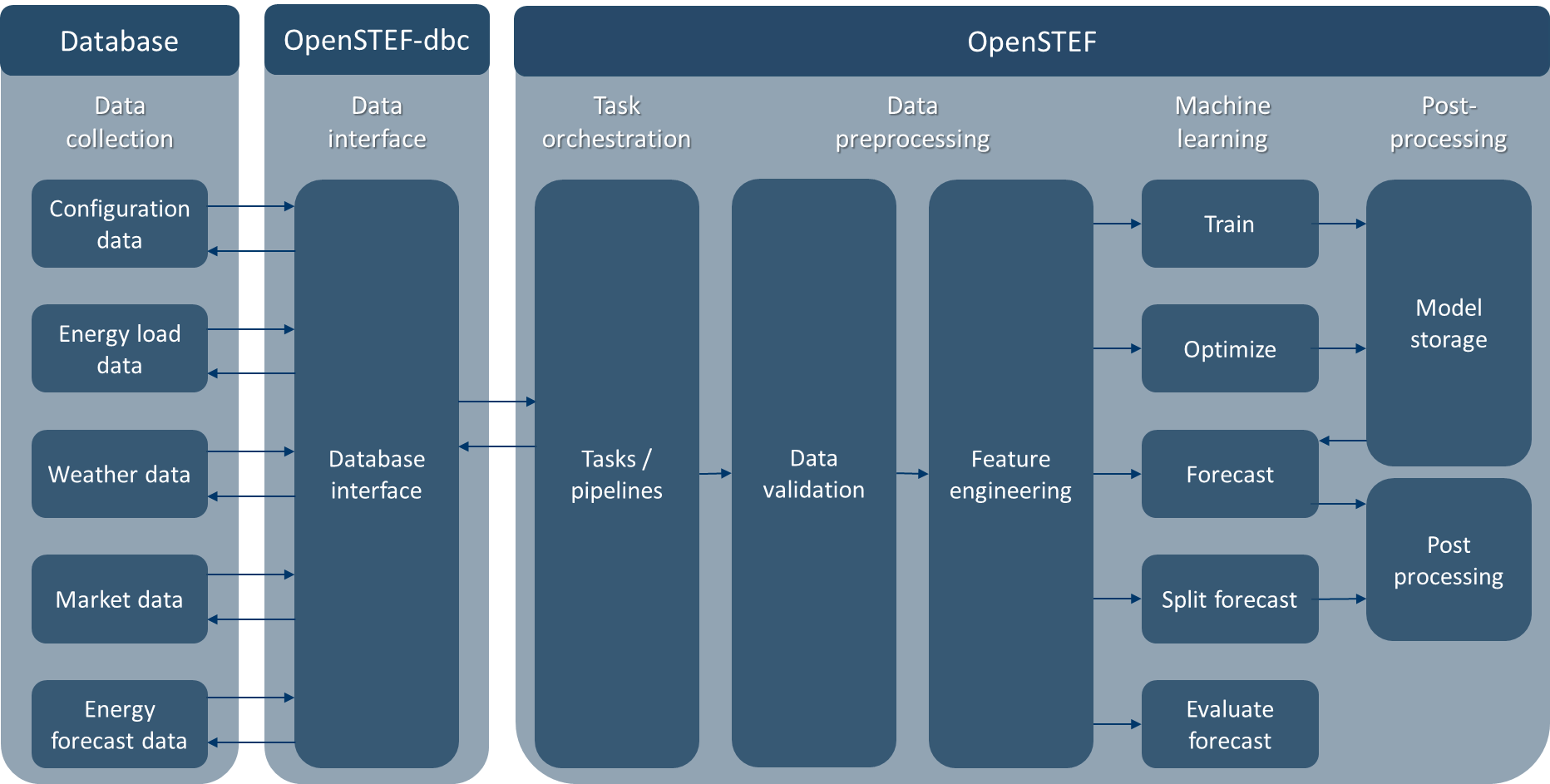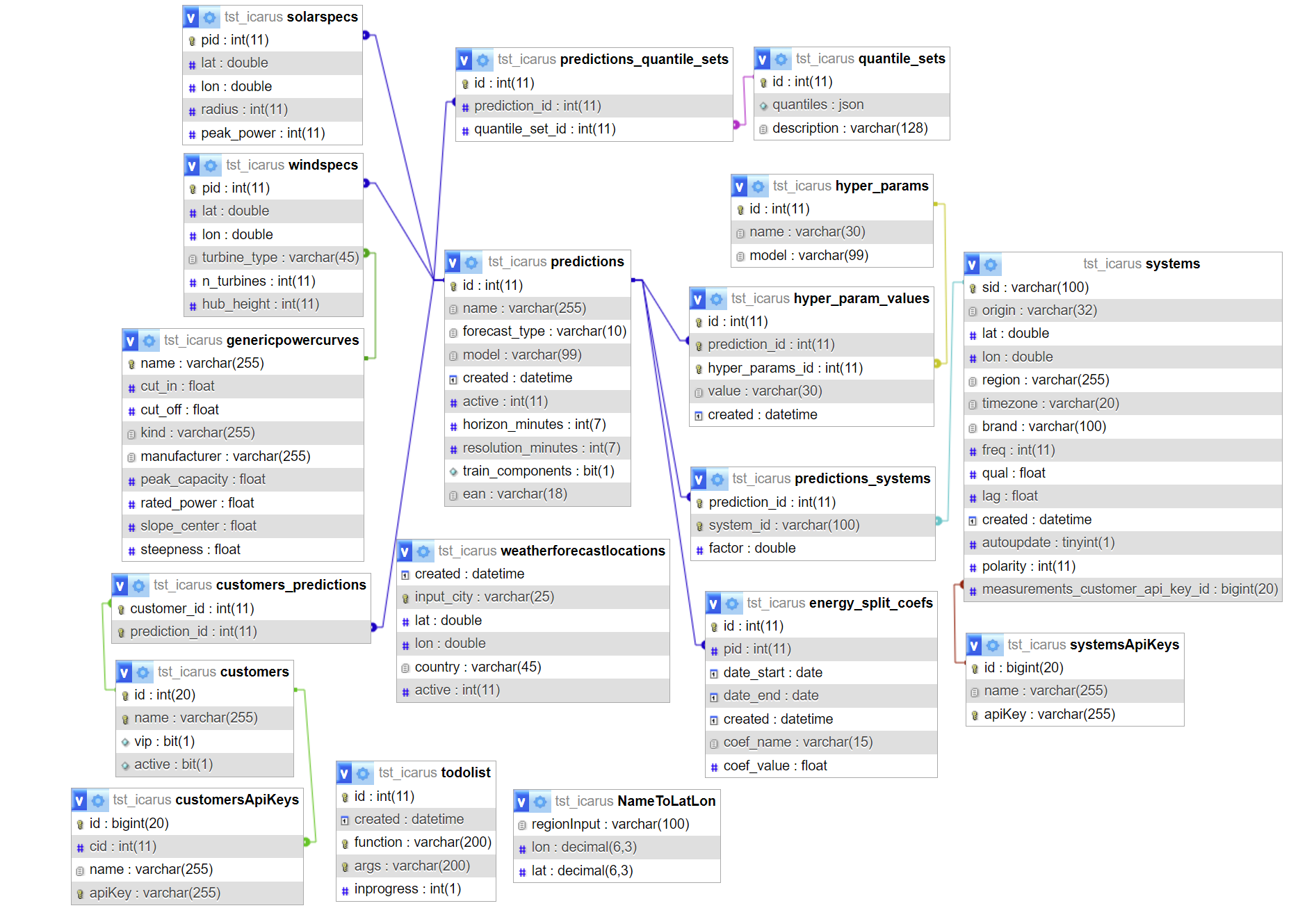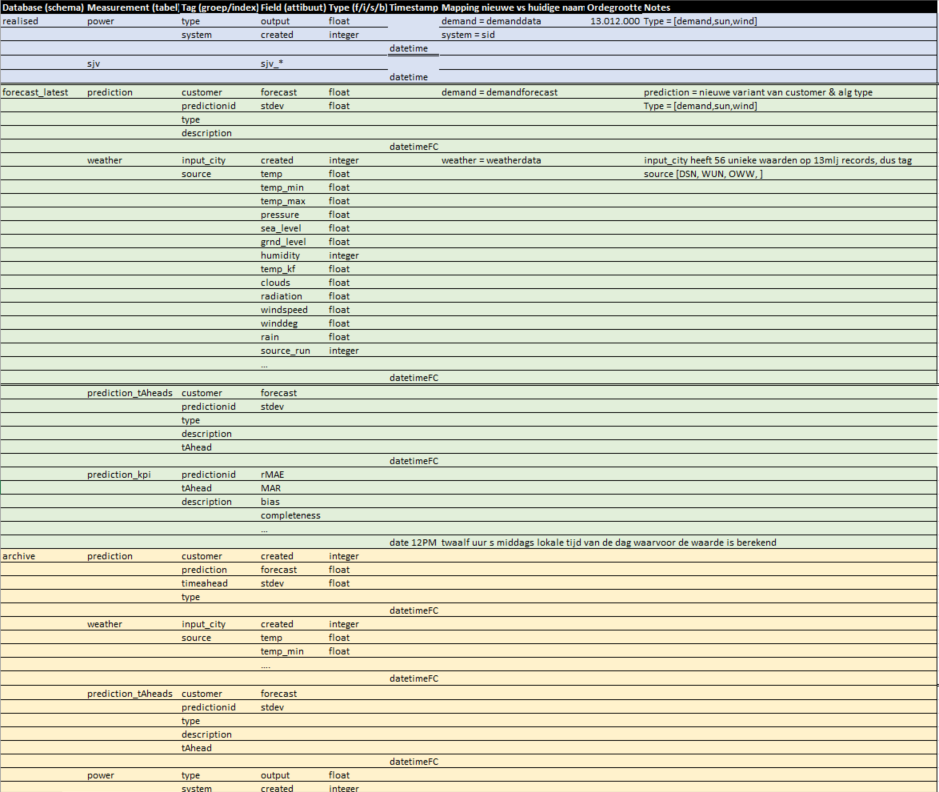Architecture, Methodology, and Components¶
Understanding the architecture of OpenSTEF will help you gain insight on how to use this software package and better understand the rest of the documentation.
Software architecture¶
OpenSTEF is set up as a Python package that performs machine learning in order to forecast energy loads on the energy grid.

OpenSTEF contains:
Prediction job: input configuration for a task and/or pipeline (e.g. train an XGB model for a certain location).
Tasks: can be called to perform training, forecasting, or evaluation. All tasks use corresponding pipelines. Tasks include getting data from a database, raising task exceptions, and writing data to a database.
Pipelines: can be called to perform training, forecasting or evaluation by giving input data to the pipeline. Users can choose to use tasks (which fetch/write data for you), or use pipelines directly (which requires fetching/writing data yourself).
Data validation: is called by pipelines to validate data (e.g. checking for flatliners).
Feature engineering: is called by pipelines to select required features for training/forecasting based on the configuration from the prediction job (e.g. create new features for energy load of yesterday, last week).
Machine learning: is called by pipelines to perform training, forecasting, or evaluation based on the configuration from the prediction job (e.g. train an XGB quantile model).
Model storage: is called by pipelines to store or fetch trained machine learning model with MLFlow (e.g. store model locally in disk/database/s3_bucket on AWS).
Post processing: is called by pipelines to post process forecasting (e.g. combine forecast dataframe with extra configuration information from prediction job or split load forecast into solar, wind, and energy usage forecast).
Tasks are provided in a separate Python package called openstef-dbc. If you need to use tasks, the openstef-dbc package is required in order to interface to databases for reading/writing. Currently, openstef-dbc supports interfaces for a MySQL database for configuration data (e.g. information for prediction jobs) and InfluxDB for feature data (e.g. weather, load, energy price data) and energy forecast data.
High level methodology OpenSTEF¶
OpenSTEF automates many typical activities in machine learning. These include the combination of input data and preparation of features. Furthermore, the train and predict methodology of OpenSTEF allows for a single-shot, multi-horizon forecast. To provide a high-level overview of these functionalities, a schematic depiction is given here.
OpenSTEF provides confidence estimates of it’s forecasts. Two methods are available. The figure below explains the differences and similarities between the two methods, as well as provide recommendations on how to the confidence estimations should be used.
Application architecture¶
OpenSTEF is simply a software package (i.e. a Python library). If you’re looking to run it as a full application with a graphical user interface frontend, you must deploy it with additional components.

Here are the recommended additional components if you want to run it as an application:
Github repositories:
(create yourself) Data fetcher: software package to fetch input data and write it to a database (e.g. a scheduled CronJob to fetch weather data in Kubernetes).
(create yourself) Data API: API to provide data from a database or other source to applications and users (e.g. a REST API).
(create yourself) Forecaster: software package to fetch config/data and run OpenSTEF tasks/pipelines (e.g. a scheduled cron job to train/forecast in Kubernetes).
(open source) OpenSTEF: software package that performs machine learning to forecast energy loads on the energy grid.
(open source) OpenSTEF-dbc: software package that provides interface to read/write data from/to a database for openstef tasks.
CI/CD Infrastructure
(create yourself) Energy forecasting Application CI/CD: Continuous Integration/Continuous Delivery pipeline to build, test, and deploy your forecasting application (e.g. to Kubernetes via Jenkins, Chef, Puppet, Tekton, etc.).
(open source) OpenSTEF package CI/CD: A set of GitHub Actions that build, test, and publish the OpenSTEF package to PyPI here when it is time to release a new version.
Compute: compute resources to run your pipelines and tasks in production (e.g. on Kubernetes using any of the various providers AWS, Azure, GCP, Linode, etc.).
Database: SQL, InfluxDB, or other database that stores fetched input data and forecasts.
Dashboard: graphical user interface dashboard that allows uers to visualize application data (e.g. historic and forecasted energy loads)

Split forecast: Domain Adaptation for Zero Shot Learning in Sequence (DAZLS)¶
DAZLS is an energy splitting function in OpenSTEF. Is a technique which
transfers knowledge from complete-information substations to
incomplete-information substations for solar and wind power prediction.
It is being used in openstef.pipeline.create_component_forecast
to issue the prediction.
This function trains a splitting model on data from multiple substations with known components and uses this model to carry out a prediction for target substations with unknown components. The training data from the known substations include weather, location, and total load information of each substation and predicts the solar and the wind power of the target substations.
The model is developed as a zero-shot learning method because it has to carry out the prediction of target substations with unknown components by using training data from other substations with known components. For this purpose, the method is formulated as a 2-step approach by combining two models deployed in sequence, the Domain and the Adaptation model.
The schema bellow depicts the structure of the DAZLS model. The input of the model is data from the complete-information substations. For every known substation we have input data, source metadata and output data. At first, we feed the input data to train the Domain model. Domain model gives a predicted output. This predicted output data, linked together with the source metadata of each substation, is being used as the input to train the Adaptation model. Then, the Adaptation model provides the final output prediction of solar and wind power for the target substations.

Domain Adaptation Model¶
For more information about DAZLS model, see:
Teng, S.Y., van Nooten, C.C., van Doorn, J.M., Ottenbros, A., Huijbregts, M., Jansen, J.J. Improving Near Real-Time Predictions of Renewable Electricity Production at Substation Level (Submitted)
HOW TO USE: The code which loads and stores the DAZLS model is in the notebook file 05. Split net load into Components.ipynb. When running this notebook, a dazls_stored.sav file is being produced and can be used in the prediction pipeline. It is important, whenever there are changes in the dazls.py, to run again the notebook and use the newly produced dazls_stored.sav file in the repository.
Overview of relational database¶
OpenSTEF uses a relational database to store information about prediction jobs and measurements. An ER diagram of this database is shown below.

The necessary tables are described in more detail bellow:
Name |
Type |
Comment |
Example |
|---|---|---|---|
id |
int |
customer id |
307 |
name |
chr |
customer name |
Location_A |
vip |
bool |
extra important forecast (deprecated) |
1 |
active |
bool |
activity status |
1 |
Customer : A customer is a collection of predictions. This can be a collection of predictions belonging to a customer but also a collection of prediction belonging to a specific location or substation.
Name |
Type |
Comment |
Example |
|---|---|---|---|
id |
int |
API key id |
94 |
cid |
int |
customer id |
307 |
name |
chr |
customer name |
Location_A |
apiKey |
chr |
API key value |
uuid-Location_A |
For users to post measurements or retrieve forecasts related to a specific customer (used internally by Alliander).
customers_predictions
Correspondence table between customer ids and prediction jobs ids.
Name |
Type |
Comment |
Example |
|---|---|---|---|
customer_id |
int |
customer id |
307 |
prediction_id |
int |
prediction job id |
313 |
Contains the generic load curves of wind turbines. These curves are two-parameters sigmoids (center and slope).
Name |
Type |
Comment |
Example |
|---|---|---|---|
name |
chr |
turbine name |
Vestas V112 |
cut_in |
float |
min wind speed to produce (m/s) |
3 |
cut_off |
float |
max wind speed to produce (m/s) |
25 |
kind |
chr |
onshore / offshore |
onshore |
manufacturer |
chr |
Enercon |
|
peak_capacity |
float |
max power (W) |
3040270 |
rated_power |
float |
rated power (W) |
3000000 |
slope_center |
float |
Wind speed corresponding to 50% of rated power (m/s) |
7.91 |
steepness |
float |
See formula |
0.76 |
In openstef/feature_engineering/weather_features.py, the power delivered by a wind turbine is computed as
where \(v\) is the windspeed at hub height, \(P_{rated}\) = rated_power, \(k\) = steepness and \(c\) = slope_center.
Name |
Type |
Comment |
Example |
|---|---|---|---|
regionInput |
chr |
region name |
Leeuwarden |
lon |
decimal |
longitude |
5.800 |
lat |
decimal |
latitude |
53.201 |
This table is used for looking up coordinates for specific locations that can be used directly for retrieving weather data.
Contains prediction jobs.
Name |
Type |
Comment |
Example |
|---|---|---|---|
id |
int |
prediction job id |
313 |
name |
chr |
customer name |
Location_A |
forecast_type |
chr |
type of forecast |
demand |
model |
chr |
type of model |
xgb |
created |
datetime |
creation datetime of the prediction job |
2019-05-16 14:53:38 |
active |
int |
0 = off; 1 = on; |
|
horizon_minutes |
int |
max forecast horizon (minutes) |
2880 |
resolution_minutes |
int |
time resolution of forecasts (minutes) |
15 |
train_components |
bool |
Optional: Carry out energy splitting for this prediction job |
1 |
ean |
chr |
EAN of the connectionpoint if the prediction corresponds to a connection point. See also: https://en.wikipedia.org/wiki/International_Article_Number |
000000000000000003 |
Prediction: A prediction is the core concept in openSTEF and largley translate to the prediction_job in the openSTEF code. To make a prediction a prediction is usualy coupled to one or more systems. These systems provide the measurement data for which a forecast is made.
Correspondence table between prediction jobs and the set of quantiles to forecast.
Name |
Type |
Comment |
Example |
|---|---|---|---|
id |
int |
22 |
|
prediction_id |
int |
prediction job id |
313 |
quantile_set_id |
int |
id of the quantile sets |
1 |
Correspondence table between prediction jobs and systems.
Name |
Type |
Comment |
Example |
|---|---|---|---|
prediction_id |
int |
prediction job id |
317 |
system_id |
chr |
system id |
Location_A_System_1 |
factor |
double |
Optional factor to multiply before addition |
-2.0 |
A prediction job can correspond to multiple systems
A system can be linked to multiple prediction jobs
When mulitple systems are coupled to a prediction all these systems are added and the forecast is made for the sum. I ffor whatever reason a system should not be added but subtracted it is possible to set the factor to -1. Is some scaling needs to be carried out in the sum the factor can be changed from 1 (default) to the desired scaling factor.
System : Represents a physical measurement system. All metadata is saved in this SQL table, the actual timeseries can be retrieved from influx by the corresponding system id.
Contains the specifications of the quantile sets.
Name |
Type |
Comment |
Example |
|---|---|---|---|
id |
int |
quantile set id |
|
quantiles |
json |
list of quantiles |
[0.05, 0.1, 0.3, 0.5, 0.7, 0.9, 0.95] |
description |
chr |
Default quantile set |
Configuration for PV forecasts for each prediction job
Name |
Type |
Comment |
Example |
|---|---|---|---|
pid |
int |
prediction job id |
123 |
lat |
double |
latitude |
51.9850343 |
lon |
double |
longitude |
5.8956792 |
radius |
int |
radius in km |
10 |
peak_power |
int |
max power |
1000 |
2 cases:
Radius = ‘None’ : when the forecast is for a specific system
Radius > 0 when the forecast is for a region
Contains informations about systems.
Name |
Type |
Comment |
Example |
|---|---|---|---|
sid |
chr |
system id |
Location_A_System_1 |
origin |
chr |
origin of the system data |
ems (energy management system = SCADA) |
lat |
double |
latitude |
5.837 |
lon |
double |
longitude |
51.813 |
region |
chr |
Gelderland |
|
timezone |
chr |
UTC |
|
brand |
chr |
additional information on measurements |
accurate_inc |
freq |
int |
additional information on measurements |
5 |
qual |
float |
additional information on measurements |
1 |
lag |
float |
additional information on measurements |
15 |
created |
datetime |
Date when the system is registred in openSTEF |
2021-01-25 09:44:00 |
autoupdate |
tinyint |
deprecated |
1 |
polarity |
int |
sign convention for production and load |
-1/1 |
measurements_customer_api_key_id |
int |
API to post measurements |
199 |
Polarity is a factor used to make the measurment comply with positive consumption and negative production of energy.
API key to retrieve systems measurements.
Name |
Type |
Comment |
Example |
|---|---|---|---|
id |
int |
API key id |
199 |
name |
chr |
Measurements |
|
apiKey |
chr |
API key value |
uuid-Measurements |
Contains the locations of the weather stations. These are used when retrieving weather data for a prediction.
Name |
Type |
Comment |
Example |
|---|---|---|---|
created |
datetime |
2023-06-08 18:26:44 |
|
input_city |
chr |
Deelen |
|
lat |
double |
52.067 |
|
lon |
double |
5.8 |
|
country |
chr |
NL |
|
active |
int |
1 |
This table is empty in openstef-reference. Contains the information for the wind power forecast related to a prediction job.
Name |
Type |
Comment |
Example |
|---|---|---|---|
pid |
int |
prediction job id |
|
lat |
double |
||
lon |
double |
||
turbine_type |
chr |
corresponds to the field ‘name’ in genericpowercurves |
|
n_turbines |
int |
number of wind turbines |
|
hub_height |
int |
height of the turbines (m) |
The hub height is used to extrapolate the wind speed forecast at the correct height.
Overview of timeseries database schema¶
OpenSTEF uses a timeseries database to store all timeseries data. A diagram of its structure is shown bellow.
